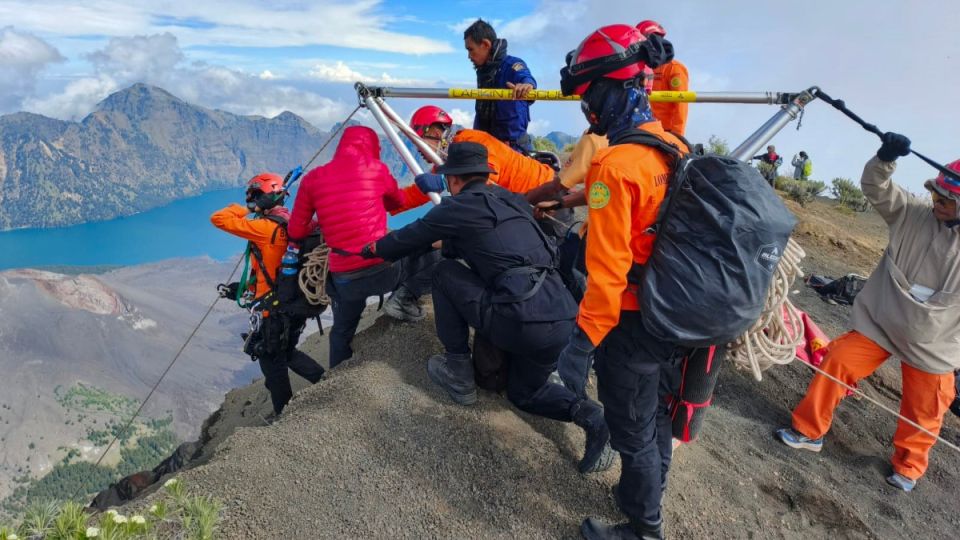July 2, 2025
JAKARTA – A Malaysian tourist was injured after slipping while trekking on Mount Rinjani in Lombok, East Nusa Tenggara, just days after a Brazilian climber died in a similar accident, raising fresh concerns over safety on Indonesia’s second-highest volcano.
According to East Lombok Police spokesperson First Insp. Nicolas Oesman, 47-year-old Nazli began his ascent of the 3,726-meter mountain on Thursday, joining a group of 12 hikers via the trail in Sajang village, Sembalun district.
After reaching the summit of Mt. Rinjani, the group began their descent toward Segara Anak Lake. It was during this leg that Nazli reportedly slipped.
“He slipped while attempting to make way for several porters passing along the narrow trail,” Nicolas said on Saturday, as quoted by Antaranews, referring to locals who help carry supplies for climbers.
Following the incident, Nazli was carried down the mountain by fellow hikers, porters and members of the local Rinjani rescue team.
He was rushed to the Sembalun Community Health Center (Puskesmas) on Saturday morning for medical treatment. He sustained bruising to his right leg, hip pain and minor scrapes to his head.
In a social media post on Saturday, the Mount Rinjani National Park Management Agency (BTNGR) stated that Nazli was in a stable condition and physically fit to resume normal daily activities.
Nazli’s fall happened just days after a fatal accident involving Brazilian tourist Juliana De Souza Pereira Marins, who died after falling into a ravine near the same area.
On June 21, Marins fell into a ravine at Cemara Nunggal, a narrow trail section near the summit, bordered by the Mt. Rinjani crater on one side and steep cliffs on the other.
Marins was believed to have survived the fall. Rescuers reported hearing her cries for help, and drone footage taken on Saturday evening showed her sitting upright partway down a 200 m-deep ravine.
However, efforts to reach her were severely hindered by poor weather and treacherous terrain. Rescuers were only able to reach her on the night of May 24, by which time she was no longer showing any signs of life.
Marins’ family has voiced frustration over what they described as sluggish and inadequate evacuation efforts by Indonesian authorities.
Their sentiments were widely echoed by Brazilian netizens, many of whom questioned the competence of the rescue teams and criticized what they saw as a lack of proper equipment to carry out the operation. Some went as far as to claim that Marins did not die from the fall itself, but as a result of the delayed rescue efforts.
National Search and Rescue Agency head Air Vice Marshal Mohammad Syafi’i expressed his condolences over Marins’ passing and denied claims that rescuers responded slowly to the accident.
“The victim’s location was extremely difficult to reach. She was trapped in a steep ravine at an altitude of 2,700 m. Rescuers had to use specialized vertical rescue equipment and battled thick fog and heavy rain, which severely limited their visibility, to reach her,” Syafi’i added.
Abd Haris Agam, a volunteer involved in Marins’ rescue, acknowledged that the operation was delayed due to insufficient equipment.
“The rope the rescue teams brought wasn’t long enough to reach the victim, so I had to fetch a 600-meter rope from the West Nusa Tenggara Search and Rescue Agency office and carry it to the mountain summit. It was heavy and took a lot of time,” he explained.
Agam urged authorities to improve rescue management on the mountain, including by providing emergency shelters near Mt. Rinjani’s summit to store evacuation equipment, allowing rescue operations to be carried out more quickly.
Following the controversy surrounding Marins’ rescue, the House of Representatives and the West Nusa Tenggara administration have announced plans to review hiking procedures and search-and-rescue protocols on Mt. Rinjani. This review will focus on regulations concerning hiking procedures and permit requirements for both domestic and international visitors.
Tourism Minister Widiyanti Putri Wardhana has also called for stricter enforcement of safety procedures on extreme hiking trails, particularly on Mt. Rinjani.
“These incidents remind us that every extreme tourism destination carries serious risks,” Widiyanti said in a press statement on Saturday.
She urged all tourism service providers to ensure that their guides and porters are properly certified and trained, to strengthen coordination with local authorities and to step up public awareness campaigns, particularly for foreign tourists, on the importance of following safety protocols.
Between 2017 and 2024, nine hikers tragically lost their lives on Mt. Rinjani due to various causes, including exhaustion and accidents.
Last month, a 57-year-old Malaysian hiker, Rennie bin Abdul Ghani, died after falling from a cliff on Mt. Rinjani. In October of last year, 16-year-old Kaifat Rafi Mubarok from Jakarta was also found dead after a fatal fall from a cliff on the mountain.


